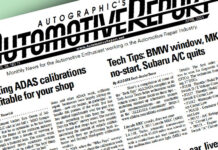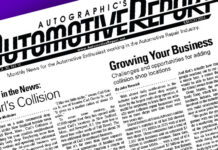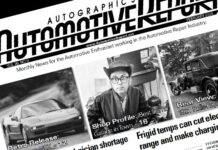By John Yoswick
As another year comes to an end, here are seven industry news briefs that might have flown under your radar amid the day-to-day challenges of running your shop, but that could prove helpful for you to know about.
1. I-CAR now offers “in-shop knowledge assessments,” to help a shop owner or manager gauge on a technician-by-technician basis which I-CAR courses would be useful and which would be redundant. I-CAR CEO John Van Alstyne said one barrier his organization sees to getting more technicians to I-CAR training is shop management that believes, “We don’t need to train because my guys already know it.” With the in-shop knowledge assessment, I-CAR will come onsite and interview technicians to determine which classes would be redundant for some or all of the shop’s technicians.
“If the technicians know it, they get credit for it,” Van Alstyne said. “If the technicians don’t know it, the shop manager or owner gets a report on what they don’t know. They also get a prescription, if you will, for the training that would close the gaps.”
Such an assessment can save the shop and its employees time, Van Alstyne said, because a 20-minute (on average) assessment could eliminate the need for a three-hour I-CAR course taken offsite.
“So it really becomes a faster path to that first level Gold Class for those that do possess that knowledge,” Van Alstyne said.
2. The percentage of shops reporting that they are being paid “always” or “most of the time” by the eight largest auto insurers when they charge an administrative fee for processing total losses has risen over the past three years.
Many shops agree to waive any such fees as part of a direct repair program. But according to the “Who Pays for What?” surveys conducted quarterly by Mike Anderson of Collision Advice in conjunction with CRASH Network, the percentage of shops that say they are regularly being paid for the fees when they do charge them has risen from 46 percent in 2015, to 53 percent in 2016, and to 57 percent in 2017.
“I fight for [other] administrative fees pretty often, and I would guess that I get them on less than 10 percent of my estimates, but I always get them on total losses, because they have to pick [those vehicles] up and they can’t leave without paying the bill,” one survey respondent from Mississippi said.
“The total loss process has continued to become more complex for shops,” Anderson said. “It can involve more tear-down, more research of OEM procedures, unloading or loading the vehicle to or from a tow truck, etc.”
Perhaps because of this, he said, the percentage of shops who said they have never billed such an administrative fee for total loss processing also has declined slightly from about 30 percent in 2015 to about 26 percent in 2017.
Collision repairers who want to sign up to take the next “Who Pays for What?” survey (in January), or get information from previous surveys, can visit: http://www.crashnetwork.com/collisionadvice
3. Although shops may be applying their higher aluminum labor rates to fewer repair operations than they were a few years ago, the hourly rates they are charging have risen consistently since 2015.
According to the “Who Pays for What?” surveys, the percentage of shops that charge a special aluminum labor rate for repairing non-structural aluminum parts has gradually declined from 481 percent in 2015 to 43 percent in 2016 and to just 40 percent as of late 2017.
In addition, about 48 percent of shops in 2015 were charging aluminum repair rates for refinishing aluminum components. That figure has also declined, down to 33 percent by 2017.
Despite these declines, the percentage of shops that charge a higher aluminum repair rate for performing structural aluminum repairs has remained constant, about 92 percent, in all three years of the survey. Although shops may be charging those higher rates for fewer repair operations, the rate itself has risen steadily over the past several years.
Looking at the median rates for structural aluminum repair, the survey found that half of all shops were charging $83 or more per hour in 2015, a figure that was $20 higher than the standard frame repair rates of $63 (median). By 2016, the median rate for structural aluminum repair had risen to $85, and by the end of 2017, the median rate had jumped again, to $90 (indicating half of all shops are now charging $90 per hour or more for structural aluminum repair).
Meanwhile, the standard frame rates in those same shops have also risen from $63 in 2015 to $70 in 2017, remaining about $20 below the median aluminum rate. Body repair labor rates, however, have remained virtually unchanged over this same time, with the national median rate hovering around $55 per hour since 2015.
The aluminum repair rates reported here are for repairs made on a vehicle make for which the shop is not certified in aluminum repair. For certified aluminum repairs, the median hourly structural rates are much higher, about $115 to $125 depending on the make, particularly with European brands.
4. Clint Marlow, auto claims director for Allstate Insurance, earlier this year said he foresees self-driving vehicles impacting the industry beyond reducing claims frequency. He predicted that in his lifetime, autonomous vehicles are less likely to be owned by individuals than they are by the vehicle manufacturers and large fleets like Uber, Lyft and even Google.
“If those companies are the owners of those vehicles, my business may not be as needed as it once was,” Marlow said. “Those are extremely large companies that will probably self-insure.”
How will repair of those vehicles be handled if they are damaged in a collision?
“My guess is that what we do here doesn’t make a whole lot of sense for Google, if they looked at it,” Marlow said. “They would have a different solution. And when it’s their own fleet, my guess is they will bring whatever solution makes sense to them when they are the owners. They can do whatever they want with those vehicles, and I think they will.”
Even ahead of the fully autonomous vehicles, Marlow said, telematics and insurer partnerships with automakers will increasingly impact claims. If an insurer has access to vehicle information about the location, speed and degree of impact of a collision, for example, the first-notice-of-loss process can be shortened to more of a discussion about whether the driver wants to make a claim.
“You can easily see how the use of telematics data might help them understand whether the vehicle is safe to drive, and maybe with the right artificial intelligence, begin to help them understand the degree of damage to [help them decide] whether they should or should not make a claim,” he said.
It could easily mean changes for shops as well, Marlow said.
“If you get an assignment from an insurance carrier and all of a sudden that came with a suggested parts list, that might be able to assist you with cycle time and to be more efficient,” he said. “All of these things are extremely plausible. If you have the telematics data, and you understand the engineering of the vehicle, you can probably make some very good assumptions based on the loss of what will need to be done to fix it.”
5. During the annual “NORTHEAST” trade show this past spring in New Jersey, Danny Gredinberg of the Database Enhancement Gateway (DEG) offered another example of the value to shops of regularly checking OEM repair procedures.
“How many of you pull procedures for interior trim panels,” Gredinberg asked attendees at his seminar at the event. “It’s pretty rare. But pulling procedures for most parts these days is going to save you time on the front-end instead of [only] finding out about things at the end of the repair.”
He cited a trim panel on the upper B-pillar of the 2016 Honda Civic that is held on by a special clip that actually must be broken in order to remove the trim panel.
“If you knew that clip needs to be broken, your technician isn’t spending an hour trying to get the panel off without breaking the clip,” Gredinberg said.
Knowing that 35-cent clip is one-time use also enables the shop to get it ordered up front “so you’re not calling the dealership at 5 p.m. on Friday afternoon needing a clip that’s not in stock.”
Gredinberg said that example also demonstrates the value of the DEG (www.DEGweb.org). Until late this past October when a CCC user submittedan inquiry through the DEG, the Motor Information Services database (used by the CCC estimating system) didn’t show the clip as available separately from the trim panel, nor did the database indicate it was a one-time use part.
“We got that changed in less than 24 hours,” Gredinberg said, noting that the few minutes it took someone to submit that inquiry to the DEG is now likely saving time and money for everyone writing an estimate involving that trim panel.
6. A number of organizations this past year have made available new or updated documents that could be of use to shops. The Automotive Service Association (ASA) has updated its free reference charts of “not-included operations” (https://tinyurl.com/ASAdoc). The association also has developed a form shops can use as a template to obtain customer authorization to conduct pre- or post-repair scanning of a vehicle (https://tinyurl.com/ScanOKform). And the National Institute for Occupational Safety and Health has developed a two-page document that addresses common questions about respirator fit testing (https://tinyurl.com/y7tbp3zu).
7. The chief financial officer of the 2,400-store Chipotle Mexican Grill chain may have seemed like a strange choice to speak at last spring’s “Repairer Roundtable” organized by the Society of Collision Repair Specialists (SCRS). But Aaron Schulenburg of SCRS said he invited Jack Hartung to help shops “think outside the box” about how companies differentiate themselves in terms of their commitment to — and investment in — quality.
“Communicating that message [to consumers] can be challenging,” Schulenburg said. “Creating sustainable business models that support that also can be really challenging.”
Hartung said that’s something his company has accomplished, paying more for humanely-raised, hormone-free meat, for example, but not charging more than comparable “fast casual” restaurants.
“We find efficiencies throughout the rest of our P&L so we can invest more in the food,” Hartung said. “We looked at the restaurant: Can we make it smaller? We don’t spend much on advertising. Would your customers rather have you spend more money on advertising, or on the materials you use to repair their cars?”
Hartung said investing in people through training is a great way to motivate them and demonstrate that the company appreciates them.
“There’s nothing worse than working a job where you’re insecure [because] you’re not sure if you’re doing it right, because no one really trained you,” Hartung said.
Trained employees who understand the company’s vision “will work really hard for you,” because “people want to work for something bigger than themselves,” Hartung said.
“If you just tell people to work hard and kick them in the ass now and again, keep kicking them and they’ll keep working hard. But when you leave, their energy level will drop dramatically.”
He said it’s also important to not keep mediocre employees around because doing so can cause good employees to leave.
“They will feel underappreciated: ‘Why am I working so hard to cover for the person next to me who is just mailing it in?’” Hartung said.
Those employees will assume management is dumb if they don’t know who the weaker workers are. If you really don’t know, Hartung said, take some employees aside and ask.
“You’ll be shocked at how much they’ll tell you,” he said. “Be ready with the flood gates. You’ll get an earful.” •
John Yoswick, a freelance writer based in Portland, Ore., who has been writing about the automotive industry since 1988, is also the editor of the weekly CRASH Network (www.CrashNetwork.com). He can be contacted by email at john@CrashNetwork.com.




